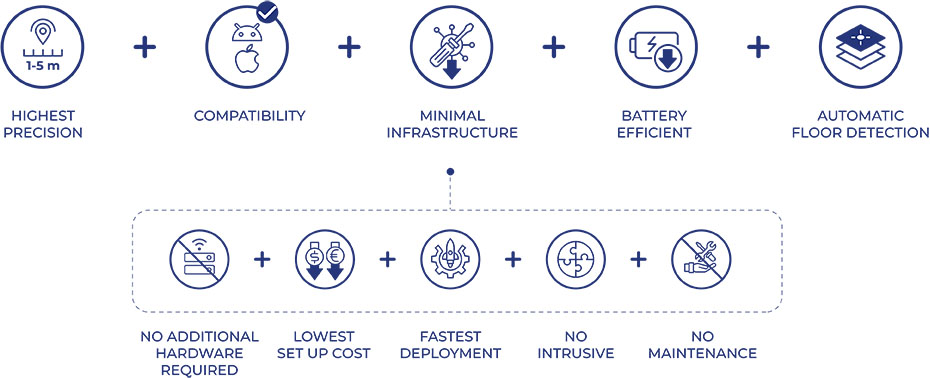More and more companies that manage large buildings and facilities are focusing their attention on indoor location technologies to improve the experience of their visitors or to optimize work processes. The selection of the indoor positioning technology to implement is the first decision to make. There are several alternatives, and they all have their advantages and disadvantages. What will determine if it is the best one for our use case is if it fits our needs according to different variables. In this post, we explain the three main aspects to take into accoun
- Indoor navigation to facilitate visitors’ stays in the building.
- Reduce the use of signage or acoustic warnings.
- Carry out geopositioned marketing actions.
- Monitor employees to increase their productivity.
- Increase the security of the facilities by restricting access to certain spaces.
The main impulse when starting the search for the technology that we are going to implement is precision.
Indoor positioning technologies accuracy
The accuracy varies from tens of meters to a few centimeters depending on the technology we use. Alternatives such as the ultra wideband can give us an accuracy of even less than 10 cm. But… do we really need to locate with such a high precision if our objective is to guide a passenger to their boarding gate or a patient to their doctor’s office? Certainly not. On the other hand, this precision has its counterpart in another fundamental aspect when choosing our indoor location solution: the infrastructure required.
Infrastructure required for the implementation of an indoor positioning system
Infrastructure required for the implementation of an indoor positioning system.
All indoor location systems need to use two basic components for positioning: emitting devices and receiving devices for the signal used to locate. Most of the receiving devices, like BLE Gateways, need an electrical and/or data connection. This means that installation and maintenance costs are high. The implementation of this infrastructure will probably require the interruption of the productive processes that are carried out in that installation. This is another fundamental point to take into account when selecting our indoor positioning system: deployment.
Indoor location technologies deployment.
Thousands of kilometers of wiring and numerous masonry works will involve numerous viability studies.They will surely also require the obtaining of authorizations from different departments of the company, many more if we talk about public spaces. A long and tedious process that may also require production stops or space closures. In short, loss of money due to hindering the flow of work, which can be critical in a factory, or uncomfortable for the visitor of an airport, hospital or shopping center.
When is Situm Indoor Positioning System the best alternative among the different indoor location technologies?
The core technology of Situm’s indoor location, indoor navigation and indoor tracking and monitoring solutions is a self-developed algorithm. This algorithm locates smartphones by combining existing Wifi and Bluetooth signals in a building with data provided by the phone’s inertial sensor

In this way, Situm can position with an average accuracy close to 1 meter, without the need for infrastructure required and with a fast deployment that can be reduced to a few days or even hours.

Our indoor positioning technology for smartphones has been successfully deployed in thousands of buildings around the world to enhance the user experience in hospitals, shopping malls and fairgrounds; facilitate transit and assistance to people with reduced mobility in busy facilities such as airports; improve efficiency in private security services or increase productivity in 4.0 industries through fleet optimization.
Situm helps hundreds of companies and organizations every day to achieve their goals: leading hospital groups such as Grupo Quirón in Spain and integrators specialized in healthcare such as Medrics in Turkey, telecommunications companies such as Telefonica in Spain and AIS in Thailand, major automobile manufacturers such as PSA or worldwide private security service providers such as Securitas..
If you are interested in finding out if Situm is the best option to implement your indoor location system, do not hesitate to contact us using the following form.
